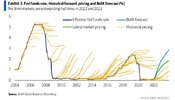2019 Autonomy Day: didn't find full transcript:
Elon Musk claims Tesla cars could be sold without steering wheels and pedals within three years
Robotaxi next year, “Probably, two years from now, we’ll make a product that has no steering wheels and pedals, and if we need to accelerate that time, we’ll just delete parts. It’s easy.”
2020 Battery day:
Tesla 2020 Battery Day Transcript September 22
"And I think probably, like I said, about three years from now, we’re confident we can make a very compelling $25,000 electric vehicle that’s also fully autonomous."
Sure, 'about 3 years', 'can make', but focusing on timing wording overlooks the most critical gating function: fully autonomous.
Thus, no one should even begin to expect the $25k car until after FSD is fully operational.
And there are cells...
And there are chips...
And there is factory capacity...
The most critical gating function on the $25K car is whether making it helps or hurts the mission. In other words, does Tesla
want to make it? Elon's statement was he was confident the $25K car
could be made in three years, not that they
would make it in 3 years. The incredible demand for the 3&Y that stretches months or even a year in some cases, completely negates the need to make a cheaper car, at this time. The need for the $25K car was
always predicated on running out of demand for cars as expensive as Model 3. But we still can't see the limit in demand for Models 3 & Y!
This is
good news, people! As usual the naysayers choose to not understand the very thing they previously said was most important, that demand for cars costing $40K and above is not large enough to support a company like Tesla being anything but a niche player. Now that they learn the demand limit for EV's in the higher price categories are far beyond what they claimed, they do not say, "Oh, wow, Tesla is killing it", LOL! No, now they try to turn this unprecedented demand for more expensive cars into a negative - "Oh, no! No cheaper car!" while ignoring the very reason there is no cheaper car is because Tesla can sell so many more expensive ones than they thought!
You can't make this stuff up, pure idiocy. Don't worry, it probably won't take too long for the smarter people with money to invest to act on this. This has been a re-occurring theme with Tesla for a few years now. Mind-blowing earnings are released, and the stock sells off. Then, over the next week or two or three, the buying builds. Sometimes slowly, sometimes suddenly. But, often, the buying picks up steam on no news and just keeps accelerating. Smart people with tens or hundreds of millions to invest often don't like to act with haste. They sit back and observe and deploy assets after the dust has settled and the value is clear. They often dollar cost average and add more as the price rises.
The biggest wildcard right now is that many investors of this type would like more visibility on the macro environment. TSLA can't rally as strong as we would like until the concerns with the overall market have abated. It's impossible to tell how long that will take but don't be surprised if it's not very long. These kinds of things are impossible to predict consistently and thus the most profitable way to proceed, time and time again, is to assume it won't be long. That is the only assumption that assures you get all of TSLA's gains over time. This holds true, on average, whether holding or buying. That's why statistics show beyond a reasonable doubt that time in the market beats trying to time the market.




